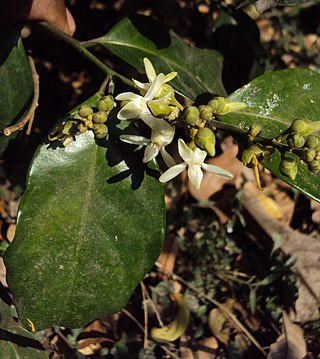
Xanthophyllum is a genus of about 109 species of trees and shrubs, of the plant family Polygalaceae;. The generic name is from the Greek meaning "yellow leaf", referring to how the leaves are often yellow when dry. In Borneo it is known as minyak berok in Malay or nyalin in the Iban language.
Payena khoonmengiana is a tree in the family Sapotaceae. It is endemic to Borneo and known only from Sabah.
Xanthophyllum beccarianum is a tree in the family Polygalaceae. It is named for the Italian botanist Odoardo Beccari.
Xanthophyllum bicolor is a tree in the family Polygalaceae. The specific epithet bicolor is from the Latin meaning 'two-coloured', referring to the different colours of the leaf and petiole.
Xanthophyllum brachystachyum is a tree in the family Polygalaceae. The specific epithet brachystachyum is from the Greek meaning 'short spike', referring to the shortness of the inflorescence.
Xanthophyllum ceraceifolium is a tree in the family Polygalaceae. The specific epithet ceraceifolium means 'waxy leaf', referring to the appearance of the leaves.
Xanthophyllum adenotus var. arsatii is a plant in the family Polygalaceae. It grows as a tree or shrub.

Xanthophyllum flavescens is a plant in the family Polygalaceae. The specific epithet flavescens is from the Latin meaning "becoming yellow', referring to the leaves.
Xanthophyllum impressum is a tree in the family Polygalaceae. The specific epithet impressum is from the Latin meaning 'impressed', referring to the enclosed position of the axillary buds.
Xanthophyllum korthalsianum is a tree in the family Polygalaceae. It is named for the Dutch botanist Pieter Willem Korthals.
Xanthophyllum lineare is a tree in the family Polygalaceae. The specific epithet lineare is from the Latin meaning 'line', referring to the linear shape of the leaves.
Xanthophyllum macrophyllum is a plant in the family Polygalaceae. The specific epithet macrophyllum is from the Greek meaning 'large leaf'.
Xanthophyllum montanum is a tree in the family Polygalaceae. The specific epithet montanum is from the Latin meaning 'mountainous', referring to the tree's habitat.
Xanthophyllum neglectum is a tree in the family Polygalaceae. The specific epithet neglectum is from the Latin meaning 'neglected', referring to how the species has been long overlooked.
Xanthophyllum nitidum is a tree in the family Polygalaceae. The specific epithet nitidum is from the Latin meaning 'shiny', referring to the leaf surfaces.
Xanthophyllum pachycarpon is a tree in the family Polygalaceae. The specific epithet pachycarpon is from the Greek meaning 'thick fruit', referring to the thick wall of the fruit.
Xanthophyllum rectum is a tree in the family Polygalaceae. The specific epithet rectum is from the Latin meaning 'upright', referring to the inflorescences.
Xanthophyllum reticulatum is a plant in the family Polygalaceae. The specific epithet reticulatum is from the Latin meaning 'netted', referring to the leaf veins.
Xanthophyllum tenue is a tree in the family Polygalaceae. The specific epithet tenue is from the Latin meaning 'slender', referring to the twigs.
Xanthophyllum griffithii is a tree in the family Polygalaceae. It is named for the British botanist William Griffith.


